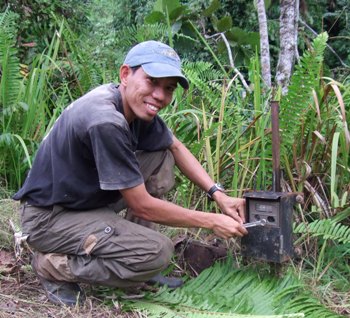The last time the hairy-nosed otter (Lutra sumatrana)
was seen in Borneo it was road-kill, but researchers have now
photographed a living individual of this elusive and endangered species.
Photos were taken by camera trap in the Dermakot forest in Sabah, a
state of Malaysian Borneo. While the last specimen known in Borneo was
killed by a car in 1997, the species hasn't been found confirmed in
Sabah for over a century.
"This is great news for Sabah and shows once again how unique and fortunate we are in terms of wildlife and nature. In addition, these findings also boost the conservation of this endangered otter internationally as historically this otter was distributed throughout large parts of southeast Asia," said Sabah Wildlife Department (SWD) Director, Dr. Laurentius Ambu, in a press release.
"This is great news for Sabah and shows once again how unique and fortunate we are in terms of wildlife and nature. In addition, these findings also boost the conservation of this endangered otter internationally as historically this otter was distributed throughout large parts of southeast Asia," said Sabah Wildlife Department (SWD) Director, Dr. Laurentius Ambu, in a press release.
The
photos were taken as apart of the Conservation of Carnivores in Sabah
(ConCaSa) program, which began in 2008 to study the state's carnivores,
including wild cats, civets, and otters. The project is being carried
out by the Leibniz Institute for Zoo and Wildlife Research (IZW) with
help from the SWD and the Sabah Forestry Department (SFD).
The identity of the hairy-nosed otter was verified by a number of exports given how similarly different otters can appear. The hairy-nosed otter is listed as Endangered by the IUCN Red List and is considered one of the world's most threatened otters. Individuals have been found in a number of other Southeast Asian countries, including Thailand, Vietnam, and Cambodia, yet the otter is most threatened by poaching for meat and traditional medicine uses. It has also been hit by pollution, habitat destruction, and loss of prey due to overfishing. According to the IUCN the otter population has been cut in half in the past thirty years.
The Deramakot forest is an FSC-certified forest managed by the SFD with an eye towards sustainable logging.
"These findings show that long-term sustainable forest management is of great importance for the protection of some of this country’s most threatened species and of the unique biodiversity of the forests of Borneo," said Datuk Sam Mannan, Director of the SFD.
The identity of the hairy-nosed otter was verified by a number of exports given how similarly different otters can appear. The hairy-nosed otter is listed as Endangered by the IUCN Red List and is considered one of the world's most threatened otters. Individuals have been found in a number of other Southeast Asian countries, including Thailand, Vietnam, and Cambodia, yet the otter is most threatened by poaching for meat and traditional medicine uses. It has also been hit by pollution, habitat destruction, and loss of prey due to overfishing. According to the IUCN the otter population has been cut in half in the past thirty years.
The Deramakot forest is an FSC-certified forest managed by the SFD with an eye towards sustainable logging.
"These findings show that long-term sustainable forest management is of great importance for the protection of some of this country’s most threatened species and of the unique biodiversity of the forests of Borneo," said Datuk Sam Mannan, Director of the SFD.
 The hairy-nosed otter (Lutra sumatrana). Researcher Azlan Mohamed setting up one of the automated camera traps in the Deramakot Forest Reserve. Photo courtesy of ConCaSa. |
"These results mean that out of 25 known carnivore species in Borneo, our project, together with a Japanese researcher Hiromitsu Samejima, confirmed 20 in Deramakot. This makes Deramakot outstanding for being extremely rich in its diversity of carnivores," said Andreas Wilting, project leader of the IZW.

The "rediscovered" hairy-nosed otter (Lutra sumatrana). Photo by: Mohamed & Wilting, SWD, SFD.

A photograph of the banded civet (Hemigalus derbyanus), note another automated camera trap on the opposite side. Photo by: Mohamed & Wilting, SWD, SFD.

A photograph of the otter civet (Cynogale bennettii). Photo by: Mohamed & Wilting, SWD, SFD.







3 comments:
This is interesting! Kudos to the govt for emphasizing the long-sustainable forest management in Sabah.
It seems that we still have another chance to conserve the Endangered Otter which are said to be wiped out in 1997. Hope that we can make the best of this opportunity.
Hope the Sabah Wildlife Department will make an in depth study on this hairy-nosed otter so that we may find out how best to protect the species.
Post a Comment